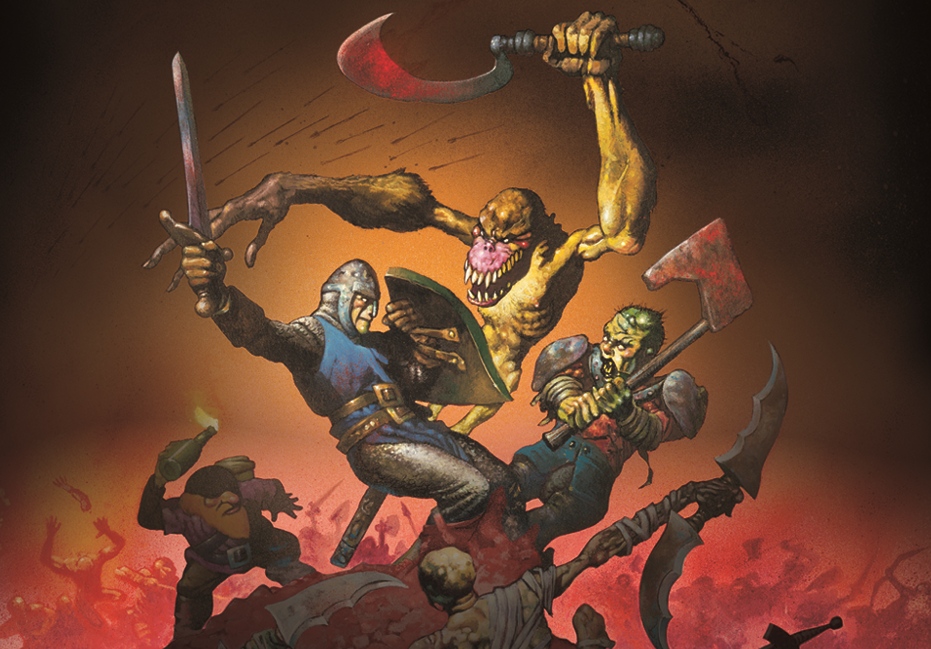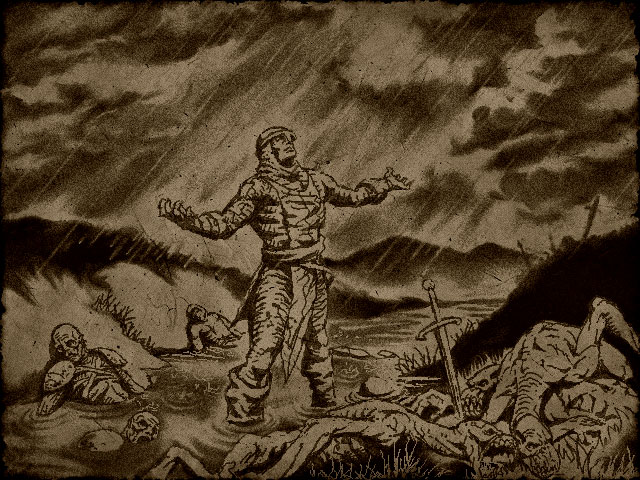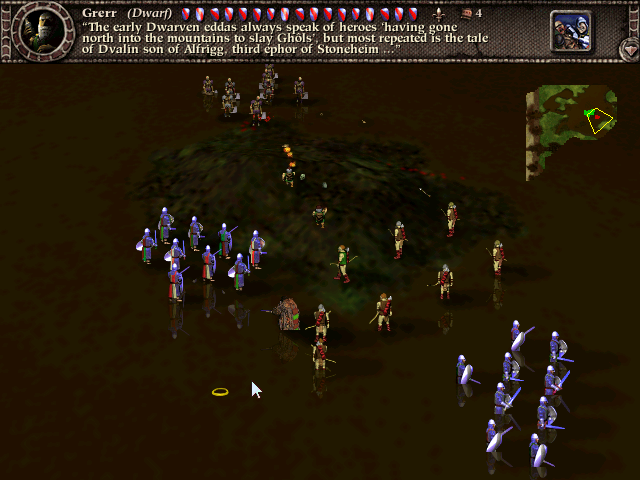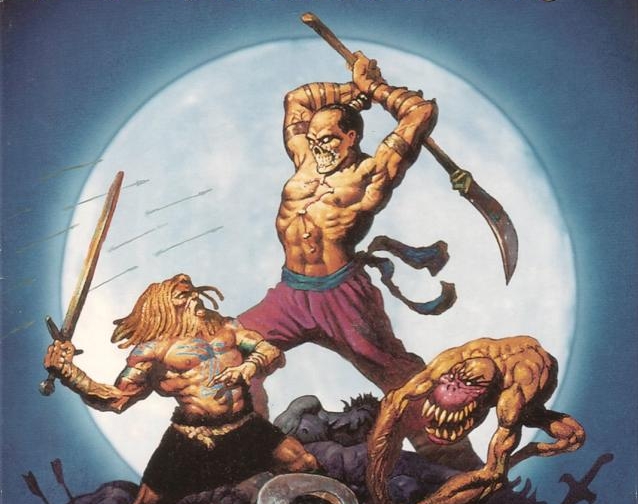This finishes up my history of Bungie during the pre-Halo years; the first part can be found here.
Part Two: Myth.
Myth is a game that is remembered for all the wrong reasons. I suspect this is at least partly down to a marketing misstep on Bungie’s part, as it was the first ever 3D strategy game and that was the element they subsequently played up in all the previews. This was a mistake; the 3D in Myth is kind of janky and horrible and doesn’t really add much to the gameplay, and what’s more the game uses 2D sprites to represent its units which doesn’t exactly help it in the looks department. As a result the first Myth game was critically panned1 as a failed experiment. Some of that criticism is fully deserved – Myth’s gameplay is, to me, a fascinating tactical challenge, but I can easily see how it would have provoked feelings of revulsion in reviewers used to the Command & Conquer RTS paradigm – but I would be willing to bet a fair amount of money that those critics didn’t get too far into the game before dismissing it out of hand. Because, once again, Bungie have turned what is otherwise a merely fairly solid game into far more than the sum of its parts through the addition of a well-told story.
The story isn’t even that original this time around. Myth draws heavy inspiration from Glen Cook’s Black Company novels2; the backstory at the start of the game is actually summed up in just three short paragraphs:
In a time long past, the armies of the Dark came again into the lands of men. Their leaders became known as The Fallen Lords, and their terrible sorcery was without equal in the West.
In thirty years they reduced the civilized nations to carrion and ash, until the free city of Madrigal alone defied them. An army gathered there, and a desperate battle was joined against the Fallen.
Heroes were born in the fire and bloodshed of the wars which followed, and their names and deeds will never be forgotten.
There’s a bit more background to be found in the manual, but for the most part this is all the scene-setting the game bothers to do. While it’s got a certain ring to it, a certain gravitas, you might think there’s only so much you can do with so brief an intro.
Ignore the intro that comes afterwards; it’s one of the more baffling design decisions in Myth to have all the cutscenes be drawn in this bright, cartoony style that’s completely at odds with the rest of the game. Those sixty seconds of narration should be all you need to convince you that Myth is going to be something special, and showcase the game’s two parallel masterstrokes in telling its story.
The first is Marty O’Donnell’s wonderfully haunting and mournful musical themes. Bungie were extremely fortunate to have O’Donnell on their staff during the Myth and Halo years because he is hands down one of the best composers working in video games today, and his score for Myth remains probably his best work. The main theme — The Fallen Lords — is a desperately evocative lament for a civilization driven to the brink of extinction, while tracks like The Five Champions emphasise the acts of heroism mentioned in the prologue and The Last Battle effectively communicates the grinding, implacable terror that is the undead horde of the Fallen. And then you’ve got The Siege of Madrigal, which was so good Bungie put a variant of it into every single Halo game they made.
By itself, the music is great. What makes it particularly effective is the way it works together with the second masterstroke, which is to tell the story through this fantastically world-weary narrator; a soldier in the Legion (the elite of the rag-tag army still resisting the Fallen Lords) who narrates his journal entries at the start of every mission. The particularly clever thing here is that the identity of the narrator is never stated, or even hinted at. All you can tell from his narration is that he’s not particularly high-up in the Legion – he could be anybody, any one of the soldiers you command during the missions. By telling the story from the perspective of one of the rank-and-file soldiers – somebody well-informed but who by means knows everything that’s going on, and who is completely at the mercy of the eddies of war – Myth really gets across how badly the battle against the Fallen Lords is going. At the start of the game the Legion has been pushed back all the way to the coast with only a tiny scrap of unconquered territory remaining, and unlike most contemporary games that’d have you taking command of the good guys and magically winning the whole war, this situation basically never changes.
As a result, no game before or since has done such a fantastic job of communicating just how hopeless the scenario facing the player is. The entire game is a constant struggle not for victory, but for basic survival. The narrator – and by extension, the Legion – doesn’t seriously expect to win the war against the Fallen Lords, but he keeps on fighting anyway because the Fallen are an enemy that will give no quarter and accept no surrender. He has no other option but to fight, and so the various missions are a series of daring raids and desperate rearguard actions fought against impossible odds. This bleak, oppressive atmosphere is one of the hallmarks of all the early Bungie games (and even the first Halo) but Myth is the one that pulls it off the best, and it’s all down to the narration and music.
Not to say that the gameplay doesn’t play a part as well. Myth is what today would be called a tactical RTS – that is, you’re sent into a mission with a certain number of troops, and you have no way of getting any more unless the mission happens to give you reinforcements at a set point. If you lose a man he cannot be replaced and you have to continue on with a diminished force. The soldiers you are given are a cut above the average undead Thrall that makes up the bulk of the Fallen forces, but there’s normally three or four Thrall for every soldier in your tiny group, and they’re mixed in with other enemies that can easily wipe out your entire force in one attack if you’re not careful. The relative fragility of your men really works well together with their finite supply; you will lose troops during a mission, and every single loss hurts.
This aspect of the game is made even better by the persistent character veterancy. Every soldier in Myth, when you click on him, will display one of several in-universe quotes describing the soldier type along with the soldier’s name. This name is randomly picked off of a list, but once assigned to a soldier it becomes fixed. That soldier then permanently carries the name through that mission and – if you keep him alive – through all subsequent missions in which he appears. The game also tracks the number of kills he has as shields displayed next to his name; once a character gets a few kills under his belt he’ll become a veteran and become slightly better at killing things. You end up carefully shepherding this small core of elite veterans through the game – just like the Legion is supposed to be – and while any losses incurred during a mission will be made good at the start of the next, the replacement soldiers will be fresh-faced recruits with none of the experience or shared history of the guy who bought it. That man is gone forever, and nothing’s bringing him back.
I hate to be banging on about world-building the whole time, important though it is, but Myth also excels in this regard. Backstory is explained both explicitly and non-explicitly in the journals and incidental details throughout the game; the flavour quotes for the soldiers hint at the world’s history and just how long this cataclysmic war has been going on for. Myth wisely leaves a lot of this story untold, with the various leaders of the Legion and the Fallen referred to by the narrator as if the player should already know who they are by their reputation alone, and this allows the player to fill in the gaps with their imagination. The geography and character types are a mishmash of different cultures that somehow works; you have medieval Warriors mixing with Nordic Berserkers, aboriginal Archers and Tolkien-esque Dwarves that love to throw explosive molotovs, and they come from disparate locations with names as diverse as Covenant, Myrgard, Bagrada and Muirthemne. This constant use of words and concepts that sound vaguely familiar to us makes Myth very, very good at conjuring up a mental image of something from the name alone.
When the time came for Bungie to make the sequel, I imagine they ran into problems at the initial design meeting when they realised they wouldn’t be able to pull off the same trick twice. After the defeat of the Fallen Lords at the end of the first game (yes, Myth doesn’t depart from genre convention so severely that that doesn’t happen, although it keeps up the illusion almost until the very last mission) the ravaged cities of the West have rebuilt their civilization. Peace has reigned for sixty years with nary a single Thrall raising its ugly head. Given this scenario it’s a bit difficult to reproduce the same feeling of being completely screwed, so Bungie decided to do something a little different. Myth II: Soulblighter starts with the narrator as part of a small company of soldiers patrolling the countryside. They run into zombies at a village called Willow Creek, and further investigation leads to a Baron with some very unsavoury habits. Things snowball from there as the situation rapidly grows beyond the ability of the patrol to handle it, and their focus switches to simply surviving the undead onslaught while making their way back to the capital to get word to the King (the sole surviving member of the group of sorcerers that led the Legion in the first game).
Myth II uses the same storytelling method as the first game – it even uses the same narrator, although he’s clearly supposed to be a different person — and despite the setup being different the game still manages to create the same impression of events spiralling beyond the player’s control. What seems to be a problem affecting a single village soon blossoms into a full-blown undead invasion that sorely outclasses the narrator’s group, and even when they make it back to the apparent safety of the capital city the chaos follows them and rips it apart with astonishing ease. The first nine or ten missions of the game are absolutely cracking as the narrator stumbles from one bad situation to another; unfortunately the game then takes a bit of a dip in quality as Soulblighter (the main bad guy) was one of the flunkies of the leader of the Fallen Lords in the first game, and the second half of the game feels a bit second-rate as the armies of the Light get their act together and focus solely on dealing with what used to be a second-rate baddie. Still, even after it lost the atmosphere of menace it was still a perfectly solid game.
I am not going to talk about Myth III. Myth III was made by a completely different company after Bungie got bought up by Microsoft and it is terrible; uglier than the first two games and with a character-driven plot (ugh) that screws with several crucial elements of the mythology. Instead I’ll spend the paragraphs I should have spent talking about a hypothetical awesome third game that rounded off the trilogy talking about the Myth series’ approach to difficulty instead.
The Myth games were somewhat unique amongst RTSes at the time for even having a difficulty setting. You fire up Command & Conquer or Red Alert and you won’t see any difficulty setting there; even the games that did bother merely gave the AI ridiculous bonuses to its unit production and left it at that. Since you can’t build units in Myth Bungie had to take a much different and far more thoughtful approach to difficulty. Lowering the difficulty meant you faced less bad guys in a mission, and the ones that were present were easier to kill. Raising it both increased the number of enemies and introduced more dangerous types of enemy, as well as making them harder to kill. Completing a mission on the very hardest difficulty setting, Legendary, sometimes meant taking on an enemy force that outnumbered you ten to one, but – crucially – since the number of troops on each side were fixed, overcoming the Legendary difficulty setting was simply a matter of mastering the control of your units to the point where they became very, very efficient killers, somewhat in the manner of a very hard platformer. It was a challenge I found far more satisfying than the ones offered by other strategy games since it required some actual thought on the part of the player as how best to use their units rather than just being able to crank out more tanks than the enemy, and was just another area where a Bungie game was some way ahead of the curve. You know what the next RTS game I played that took the same approach to difficulty was? Starcraft II. It took fourteen years for somebody to pick up that torch and run with it, strategy-wise.
Happily Bungie themselves know a good idea when they see it and used the same difficulty system when making the first Halo game – even going as far as to recycle the name of each difficulty level (Timid, Simple, Normal, Heroic, Legendary) – but Halo was a troubled beast that I could easily write a whole post on. For now, though, I’ll simply say that it seems like the product of a team that wanted to carry on the same themes they explored in Marathon and Myth, but which was now stymied by having to appeal to the mass market. This explains why Halo 2 – and to a lesser extent, Halo 3 – were almost totally devoid of those themes, instead preferring to focus on big-budget spectacle at the expense of any kind of textured world or nuanced storytelling3.
And that’s the story of Bungie software in a 5,000 word nutshell: they’re one of the classic examples of an extremely talented development studio that lost its soul to a corporate buyout. If you are interested in Myth’s story at all the Myth Journal website has all the journal entries, narration tracks and various bits and pieces of art, and full videos of the journal entries as they appear in game are available on youtube; there’s also a Let’s Play that runs through the first game from beginning to end in excruciating detail. Sadly I think tracking down the games themselves isn’t an option — I’m certainly not aware of any freeware/digital/budget versions, although if you did manage to source a copy there are some fan patches at Project Magma that will make them compatible with modern versions of Windows.
These articles are turning out to focus on what games can do besides good gameplay to make themselves particularly compelling experiences, so next week I’ll probably talk about something they can add that’s not even part of the actual game itself: a decent manual.
- Or at least it drew review scores averaging about 60-65%, which amounts to the same thing.
- I have read these, and the first three books are actually pretty good – for fantasy. Everything after that is absolutely dire.
- Please do not talk to me about ODST or Reach because I haven’t played those yet.








I am going to talk to you about ODST and Reach…
Actually I’ll leave that. Save to say that I think ODST managed something very good and soulful. So do try it out.
Re: Myth. Almost completely in agreement on each and every point. I would go so far as to say that Myth 1 and 2 are simply the best tactics/strategy games out there full stop. Nothing has beaten them and it is sad that it looks like nothing will for a while.
I fortunately still possess both my Myth CDs but they are somewhere in my pile of stuff back home in Russia so I have no easy access. My one hope is that they’ll get round to being released on GoG sooner or later…
I think I enjoyed Myth 2 a little more – there was perhaps a little less vigour to the story, but I found the tactical challenges more interesting and varied and I think I’ve replayed and re-enjoyed Myth 2 a few more times than 1.
And a word on Myth 3 – I don’t think it’s all that awful. It doesn’t hold the same charm or style at the Bungie games, but the gameplay itself is robust enough. There are some duff missions, but I can’t say I was pained to complete it.
Still, I don’t think it’s beyond Bungie to return with something as good as Myth or Marathon. They’ve at least switched their tack a few times now, and clearly aren’t keen on getting bogged down with one franchise or style or even approach (lucky escape from Halo there though). I don’t know if their Activision partnership will produce anything amazing, but perhaps after that?
I will play Reach and ODST when I have enough money to buy a new 360.
Also you didn’t think the character driven gameplay of Myth 3 (look, there’s Balor! And Shiver! And Soulblighter! And the Deciever! And they’re BEST FRIENDS 4 EVA!) went against everything the series had done up until that point?
Oh I think it did, but it also shed more light on the interesting aspect of how the Myth world worked with the cycles. Which is a pretty cool fantasy element, and well-worth exploring. It kind of made the first two myths more melancholic.
Myth 3 itself wasn’t all that great or coherent, but it was playable, and it was reasonably fun, and it injected a little more background into the world.
[...] have always had an unorthodox approach to game difficulty (see the article on Myth for more info) and Halo was no exception. It had an advantage in that the sci-fi game universe [...]
Thanks for reminding me how awesome these games were. I’m off to look for my copies.
I think your history is off on Myth, both Myth 1 and 2 were very well received by critics (only the non-Bungie Myth 3 got panned). Myth 1 was strategy game of the year in the three biggest magazines at the time in North America (PCGamer, Computer Gaming World, Computer Strategy Games Plus). Also I thought graphics were great at the time of release. The terrain, the gore, the broken arrows, and general debris on the battlefield were amazing in 1997.